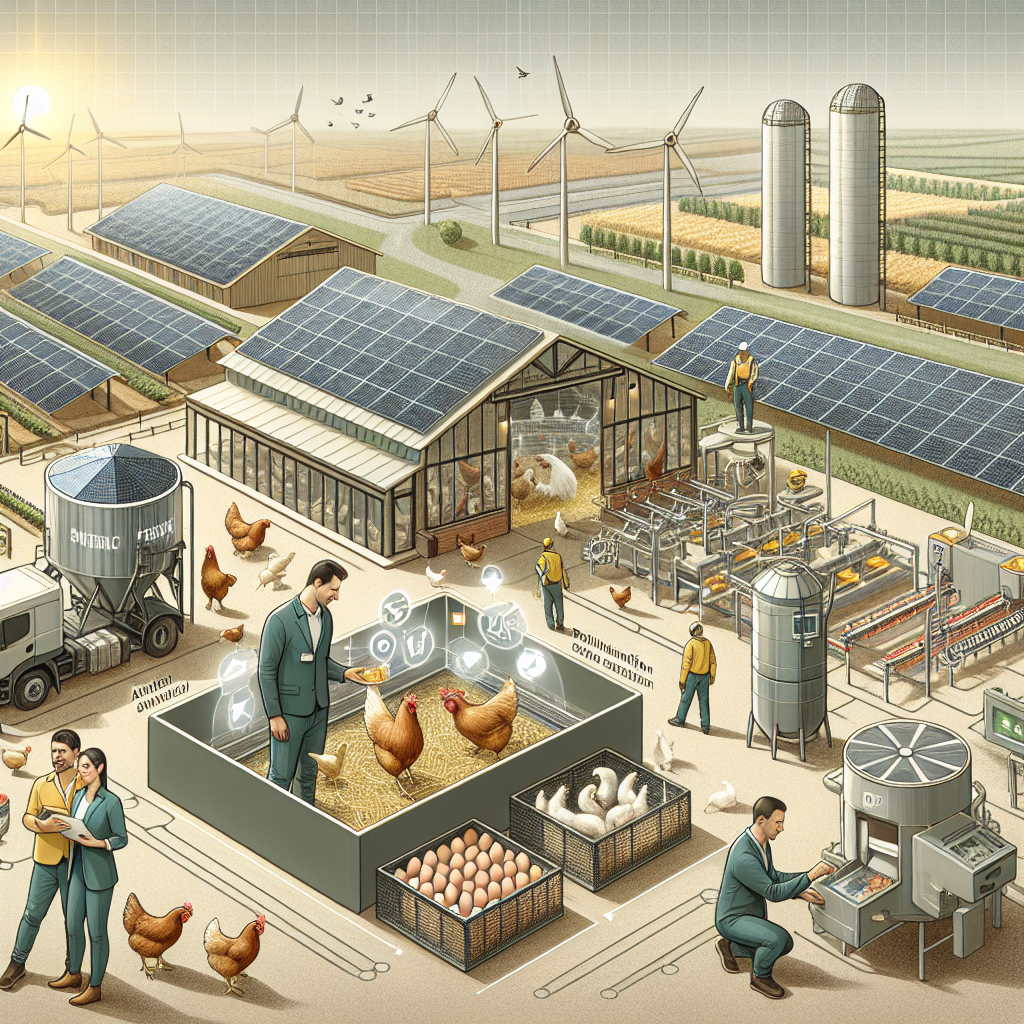Important New Technologies That Poultry Farming Industry Must Adapt
-
Table of Contents
- Revolutionizing Poultry Farming: Key Technologies for Industry Advancement
- Automated and Precision Farming Systems
- Advanced Monitoring and Data Analytics
- Genetic Engineering and CRISPR Technology
- Sustainable and Alternative Feed Sources
- Enhanced Biosecurity Measures
- Conclusion
- ETprotein: Enhancing Poultry Nutrition with High-Quality Protein Products
Revolutionizing Poultry Farming: Key Technologies for Industry Advancement

The poultry farming industry is a critical component of global food security, providing a significant source of protein to people around the world. As the demand for poultry products continues to rise, the industry must adapt to new technologies to increase efficiency, improve animal welfare, and reduce environmental impact. This article explores the important new technologies that are shaping the future of poultry farming and why it’s essential for the industry to embrace these innovations.
Automated and Precision Farming Systems
Automation and precision farming are at the forefront of agricultural innovation, offering numerous benefits to poultry producers. These technologies include:
- Automated Feeding Systems: These systems ensure that birds receive the optimal amount of feed at the right times, reducing waste and improving growth rates.
- Environmental Control Systems: Advanced climate control technologies maintain ideal conditions within poultry houses, enhancing bird comfort and health while conserving energy.
- Robotics: Robots are being used for tasks such as egg collection, cleaning, and monitoring bird health, reducing labor costs and improving efficiency.
According to a report by MarketsandMarkets, the precision farming market is expected to grow from USD 7.3 billion in 2020 to USD 12.8 billion by 2025, at a CAGR of 12.0%. This growth is indicative of the potential these technologies have to transform poultry farming.
Advanced Monitoring and Data Analytics
Data analytics and monitoring systems are critical for optimizing poultry production. These technologies include:
- Sensors and IoT Devices: Sensors can monitor a range of variables such as temperature, humidity, and air quality, providing real-time data to farmers.
- Big Data Analytics: By analyzing large datasets, farmers can identify patterns and make informed decisions to improve productivity and animal health.
- Machine Learning: AI and machine learning algorithms can predict and prevent disease outbreaks, enhancing biosecurity measures.
Research indicates that the use of big data and analytics in agriculture can increase yields by up to 20%, demonstrating the significant impact these tools can have on poultry farming efficiency.
Genetic Engineering and CRISPR Technology
Genetic engineering and CRISPR technology hold the promise of creating healthier and more productive poultry breeds. These advancements can lead to:
- Disease Resistance: Genetically modified birds that are resistant to common diseases, reducing the need for antibiotics.
- Improved Feed Conversion: Birds that can convert feed more efficiently into body mass, leading to reduced feed costs.
- Enhanced Welfare Traits: Breeds with traits that improve welfare, such as reduced aggression or better heat tolerance.
As per a study published in the journal “Transgenic Research,” CRISPR technology has the potential to significantly enhance disease resistance in poultry, which could revolutionize the industry’s approach to disease management.
Sustainable and Alternative Feed Sources
The search for sustainable and alternative feed sources is crucial for reducing the environmental footprint of poultry farming. Innovations in this area include:
- Insect Protein: Insects such as black soldier fly larvae can be used as a high-protein feed ingredient, offering a sustainable alternative to traditional soy or fishmeal.
- Algae-Based Feeds: Algae can be cultivated on non-arable land and provide a rich source of omega-3 fatty acids for poultry diets.
- Food Waste Upcycling: Upcycling food waste into poultry feed reduces waste and provides an economical feed source.
Statistics from the Food and Agriculture Organization (FAO) suggest that insect-based feeds could replace up to 30% of the current protein sources in poultry diets, highlighting the potential for significant industry change.
Enhanced Biosecurity Measures
With the threat of avian influenza and other diseases, biosecurity is more important than ever. New technologies in this area include:
- Vaccination Innovations: Needle-free vaccination methods and edible vaccines are being developed to improve the efficiency and effectiveness of disease prevention.
- Sanitation Robots: Robots equipped with UV-C light or disinfectant sprayers can autonomously sanitize poultry houses, reducing the risk of disease spread.
- Diagnostic Tools: Rapid on-site diagnostic tools allow for quick detection of pathogens, enabling prompt response to potential outbreaks.
A study by the University of Georgia showed that enhanced biosecurity measures could reduce the risk of disease outbreak in poultry farms by up to 50%, underscoring the importance of these technologies.
Conclusion
The poultry farming industry stands at the cusp of a technological revolution. By adopting automated and precision farming systems, advanced monitoring and data analytics, genetic engineering, sustainable feed sources, and enhanced biosecurity measures, the industry can meet the growing demand for poultry products while addressing environmental and welfare concerns. These technologies not only promise increased efficiency and productivity but also pave the way for a more sustainable and resilient poultry sector.
ETprotein: Enhancing Poultry Nutrition with High-Quality Protein Products
In addition to the technological advancements, the poultry industry can benefit from incorporating high-quality protein sources into feed formulations. ETprotein offers a range of organic bulk vegan proteins that can serve as excellent feed ingredients, contributing to the health and growth of poultry. Their non-GMO, allergen-free products with high purity levels are ideal for meeting the nutritional needs of poultry while adhering to industry standards for sustainability and animal welfare.
About ETprotein:
ETprotein, a reputable protein and L-(+)-Ergothioneine (EGT) Chinese factory manufacturer and supplier, is renowned for producing, stocking, exporting, and delivering the highest quality organic bulk vegan proteins and L-(+)-Ergothioneine. They include Organic rice protein, clear rice protein, pea protein, clear pea protein, watermelon seed protein, pumpkin seed protein, sunflower seed protein, mung bean protein, peanut protein, and L-(+)-Ergothioneine EGT Pharmaceutical grade, L-(+)-Ergothioneine EGT food grade, L-(+)-Ergothioneine EGT cosmetic grade, L-(+)-Ergothioneine EGT reference grade and L-(+)-Ergothioneine EGT standard. Their offerings, characterized by a neutral taste, non-GMO, allergen-free attributes, with L-(+)-Ergothioneine purity over 98%, 99%, cater to a diverse range of industries. They serve nutraceutical, pharmaceutical, cosmeceutical, veterinary, as well as food and beverage finished product distributors, traders, and manufacturers across Europe, USA, Canada, Australia, Thailand, Japan, Korea, Brazil, and Chile, among others.
ETprotein specialization includes exporting and delivering tailor-made protein powder and finished nutritional supplements. Their extensive product range covers sectors like Food and Beverage, Sports Nutrition, Weight Management, Dietary Supplements, Health and Wellness Products, and Infant Formula, ensuring comprehensive solutions to meet all your protein needs.
As a trusted company by leading global food and beverage brands and Fortune 500 companies, ETprotein reinforces China’s reputation in the global arena. For more information or to sample their products, please contact them and email sales(at)ETprotein.com today.












